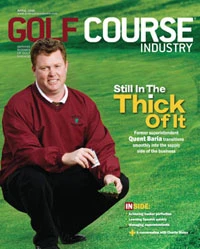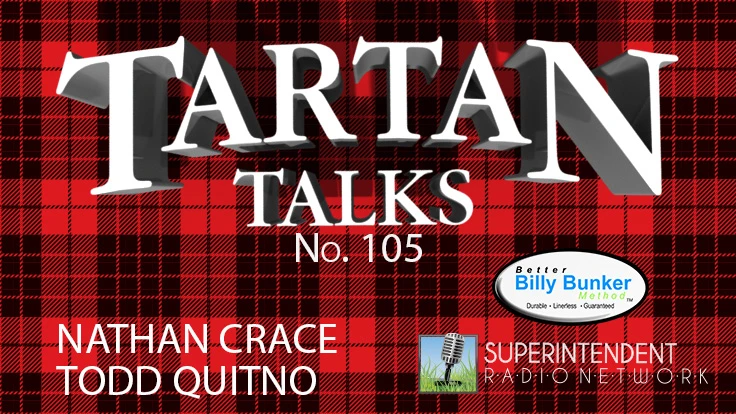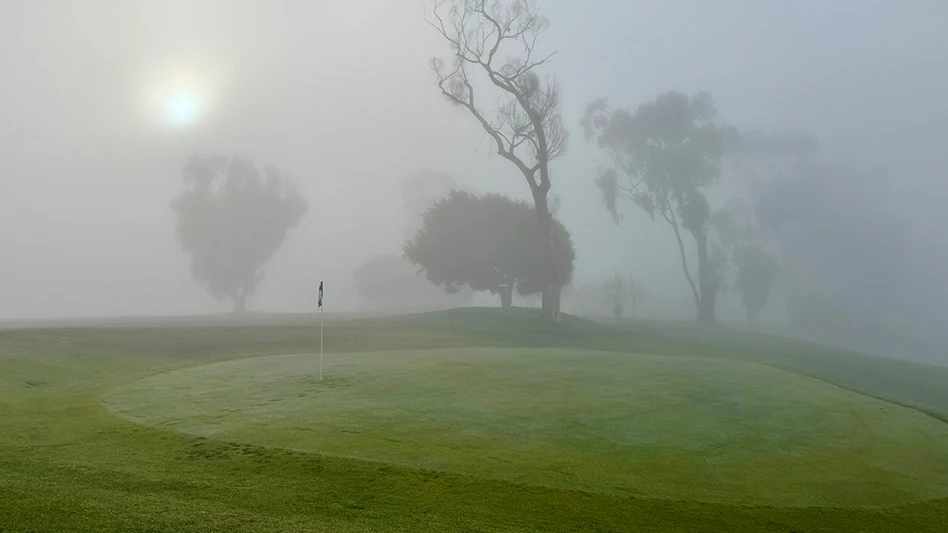Globetrotting consulting agronomist Terry Buchen visits many golf courses annually with his digital camera in hand. He will share helpful ideas relating to maintenance equipment from the golf course superintendents he visits – as well as a few ideas of his own – with timely photos and captions that explore the changing world of golf course management.
Weigh it down
Ryan Renovaire pull-type fairway aerifiers/slicers have built-in weight trays so additional weight can be added in order for the blades to penetrate more effectively into heavy soils. Tom Athy, CGCS, at Omaha Country Club in Nebraska, uses concrete cylinders for added weight while aerifiying/slicing heavy soils. Each cylinder measures 12-inches long and 6-inches in diameter and weighs about 28 pounds. Four cylinders per weight tray equals about 112 pounds. The concrete cylinders were acquired free of charge from a local concrete-strength, quality-control testing company. The original weight-tray sides were extended by welding used fairway mower bedknifes on the three outer sides. The original inner sides were cut off with an acetylene torch so the cylinders can lay end to end. The cylinders are kept in place with quarter-inch-thick steel strappings, which are positioned over the top of the cylinders extending the full length of each weight tray. Half-inch-diameter holes were drilled on either end of the strappings so they can slide over the vertically placed rebar. The strappings are wired to the rebar on each end to keep them in place.
Sweep it in
The Toro 5020 Sand Pro is equipped with an optional factory spiker attachment, which is about 60-inches wide. Adolfo Garcia, superintendent at the Chileno Bay Club in Cabo San Lucas, BCS, Mexico, added brushes to it for sweeping topdressing into the spiker holes and turf surface. He purchased two large, stiff industrial brushes that are slightly wider than the spiker attachment. Both brushes are mounted to a metal frame using quarter-inch-thick flat steel bolted to 1.5-inch angle iron, which is spot-welded onto two pieces of 1.5-inch square tubing. The other end of the square tubing has a 1-inch diameter piece of steel pipe welded to it. It’s mounted to the Sand Pro in such a way that allows the brushes to be placed in a raised position for transportation. Garcia topdresses the greens and then uses the spiker attachment and brushes to sweep the topdressing into the spiker holes and turf surface. The brushes cost about $75 each. The steel materials cost about $35, and the mechanic’s labor took about 2.5 hours. GCI
Terry Buchen, CGCS, MG, is president of Golf Agronomy International. He’s a 38-year, life member of the GCSAA. He can be reached at terrybuchen@earthlink.net.
Get curated news on YOUR industry.
Enter your email to receive our newsletters.
Explore the April 2008 Issue
Check out more from this issue and find your next story to read.
Latest from Golf Course Industry
- Beyond the Page 65: New faces on the back page
- From the publisher’s pen: New? No way!
- Indiana course upgrades range with synthetic ‘bunkers’
- Monterey Peninsula CC Shore Course renovation almost finished
- KemperSports and Touchstone Golf announce partnership
- PBI-Gordon Company hires marketing manager Jared Hoyle
- Mountain Sky Guest Ranch announces bunker enhancement project
- GCSAA names Joshua Tapp director of environmental programs





